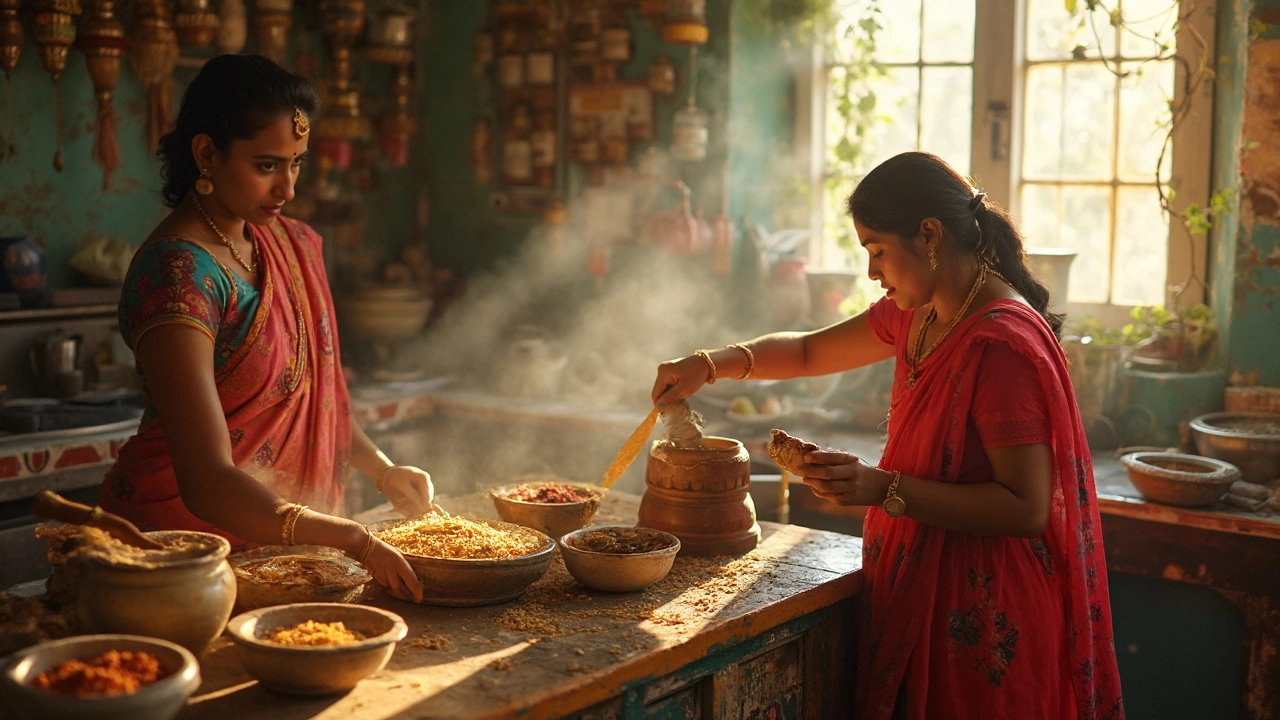Fast Hacks for Quick Dosa Batter Fermentation at Home
 Feb, 17 2025
Feb, 17 2025
Getting your dosa batter to ferment quickly is like coaxing a shy guest to join the party - it just needs the right atmosphere. First off, always grind your rice and urad dal to a silky smooth consistency, just like your favorite silk sari. A pinch of fenugreek seeds can be a game-changer, adding flavor and speeding up fermentation.
Temperature is key - warmer environments help the batter bubble to life. If Mumbai's heat isn't working fast enough, try putting the batter in a slightly warm oven (just warm, not hot!) or near a heat source. Not too close though, we don’t want a kitchen accident!
Short on time? Adding a tablespoon of yogurt can give the fermentation a jump start. But, don’t go overboard - this isn't a lassi recipe!
Stick around to learn more nifty tricks for getting your dosa batter ready in a jiffy, ensuring you never face flat, flavorless dosas again!
- Understanding the Basics of Dosa Batter
- Choosing the Right Ingredients
- Creating the Perfect Environment
- Quick Fermentation Techniques
- Troubleshooting Common Fermentation Issues
Understanding the Basics of Dosa Batter
Making a perfect dosa batter is an art, but don't worry, even a newbie in the kitchen can master it with a little practice. Dosa, the delightful South Indian pancake, primarily uses two basic ingredients: rice and urad dal (black gram lentils). The magic begins when these two partner up.
Proportion and Type Matter
Typically, the ratio of rice to urad dal is about 3:1. However, some families swear by a 2:1 ratio for fluffier dosas. Experiment to find your preference. As for rice, the regular everyday variety does the job, but parboiled rice can make your dosa batter easier to ferment and a bit crispy.
The Fenugreek Trick
Many home cooks add a small spoonful of fenugreek seeds. It's not just for the subtle flavor, but these little seeds help in creating a better texture and aid in fermentation, acting like those secret handshakes among friends.
Water: The Silent Hero
The amount of water you add is crucial. Think of achieving a consistency that coats the back of a spoon, not too thick, not too runny. Cold weather might call for a slightly thicker batter since it tends to thin out during fermentation tips.
Science of Soaking
This isn’t just an overnight soak-and-forget affair. Proper soaking is important for smooth batter and helps the grains absorb water evenly. Usually, six to eight hours does the trick. Just don't cut corners here.
Grinding to Perfection
In a world of shortcuts, the traditional wet grinder is a keeper for dosa lovers. A high-speed blender can be an alternative, but be careful not to overheat the batter while grinding, as this can affect fermentation.
These basics lay down the foundation. If you get them right, you're already halfway to enjoying those crispy, golden dosas. Stay tuned for more hacks and insights into this delicious journey!
Choosing the Right Ingredients
The magic of a perfect dosa batter begins with the right ingredients. Let's start with the rice. Ideally, you want a blend of parboiled rice and regular rice. Parboiled gives that crispiness we all crave, while regular rice ensures the dosa doesn't get too hard.
Picking the Right Dal
Urad dal is your other key player here. Go for the whole variety if you can. It's got that extra bit of starch and nutrients which help the fermentation process. If you're out, split urad dal is a decent backup.
Adding a Touch of Fenugreek
Now, for the secret ingredient that many swear by - fenugreek seeds. A small pinch not only enhances flavor but speeds up fermentation. How? Fenugreek acts like a natural fermenting agent, helping the batter rise better and faster.
Water Quality Matters
We've all heard it: not all water is created equal. Use filtered water for mixing your batter. Tap water might contain chlorine, which can slow down or even inhibit fermentation.
Yogurt: The Fermentation Booster
When time is running out, a spoonful of yogurt can give the fermentation a turbo boost. The good bacteria in yogurt blend well with the batter and kickstart the whole process.
Here's a little summary of ingredient proportions:
| Ingredient | Quantity | Purpose |
|---|---|---|
| Parboiled Rice | 3 cups | Crisp texture |
| Regular Rice | 1 cup | Softness and structure |
| Urad Dal | 1 cup | Fermentation and flavor |
| Fenugreek Seeds | 1/2 tsp | Fermentation booster |
| Yogurt (optional) | 1 tbsp | Quick fermentation |
Armed with these tips, you're all set to whip up a batter that's primed for quick fermentation. Remember, the fresher your ingredients, the better your dosa will taste!

Creating the Perfect Environment
Getting your dosa batter to ferment just right often comes down to the surroundings you provide. The ambient temperature plays a crucial role. The aim is to create a cozy spot for those little microbes in the batter to work their magic. Generally, dosa batter loves a temperature range of 25-30°C. Anything cooler, and the process will drag on longer than your favorite Bollywood epic.
So, how do you go about setting it up? In winter or cooler climates, try placing the batter inside your oven with just the light on. It's warm enough for the batter, but not too much that you end up cooking it. Another hack is to wrap the container in a thick towel or woolen cloth to keep the chill at bay. In Mumbai, we’re often blessed with enough warmth, but on a particularly cold or rainy day, these tricks come in handy.
Watch Out for Overfermentation
Nobody likes an overly sour dosa. Keeping an eye on your batter is key. Once you notice it doubling in size and a nice fluffy texture developing, get it into the fridge unless you're ready to make dosas right away. This stops it from fermenting to a point where the tang takes over.
| Temperature | Fermentation Time |
|---|---|
| Below 20°C | 24-30 hours |
| 20-25°C | 12-18 hours |
| Above 25°C | 8-10 hours |
Remember, the perfect environment is like a cushion – comfortable but not too soft. Experiment a bit based on your kitchen setup, and you'll have that dosa batter fermenting like a pro in no time!
Quick Fermentation Techniques
When you're craving dosas but time isn't on your side, quick fermentation techniques can save the day. Let's talk about ways to speed up the process without compromising on taste or texture.
Warmth is Your Ally
The secret to accelerating the fermentation process lies in maintaining warmth. Now, not everyone has the sun blazing like it does in tropical climates, right? But don’t worry! You can still create a cozy environment for your dosa batter. Preheat your oven to its lowest setting for a few minutes, turn it off, then place the batter inside. Just don't forget it's there!
Use a Kickstarter
Dosa batter loves a good starter. Stirring in a tablespoon of sour yogurt or even buttermilk can give the natural fermentation a swift kick. Some folks also add a bit of sugar to provide the yeast a quick energy boost – after all, who doesn't work better with a little sweetness?
Kitchen Hacks
- Wrap the batter bowl with a warm, damp cloth. It holds heat and adds a touch of extra moisture, which the yeast in the batter loves.
- Store the batter in an enclosed cabinet near a warm appliance, like a fridge or water heater. It's like giving it a warm hug.
Use a Rice Cooker
If you have a rice cooker with a 'keep warm' setting, it can serve double duty. Place the batter bowl in the cooker, being sure not to switch to 'cook' mode. It maintains a warm temperature perfect for fermentation.
| Technique | Time Saved | Effectiveness (1-5) |
|---|---|---|
| Oven Warming | 4 hours | 4 |
| Yogurt Addition | 3 hours | 5 |
| Warm Cloth Wrap | 2 hours | 3 |
| Rice Cooker | 4 hours | 4 |
These tricks are especially handy when the weather doesn't cooperate, or you've just decided you can't wait long for those delicious, crispy dosas. So, next time you’re running out of time, try these out and let that dosa batter grow nice and bubbly!

Troubleshooting Common Fermentation Issues
So, you followed all the tricks, and your dosa batter is still throwing a tantrum and not fermenting as it should. Don’t throw in the towel just yet. Let's tackle those stubborn issues head-on.
Why Isn't My Batter Rising?
This is a classic hiccup, especially in cooler climates. First, give it a warm hug by placing it in a warmer spot. If that’s not helping, try adding a smidgen more yogurt next time for an extra helping hand.
Is My Batter Too Sour?
If your batter’s turning out too sour, it might be over-fermented. Reduce the fermentation time next round. A quick check during the process can save you from ending up with tangy dosas which might not be everyone's cup of tea.
Consistency Concerns
Thick and stodgy batter? Mix in a bit of water slowly until it's pancake batter-like. Too runny? Add some rice flour and give it a good stir.
Strange Smells?
A funky smell indicates over-fermentation or bad hygiene. Make sure you're using clean utensils and storing your batter in a clean place.
Need a Quick Stat Fix?
Fun fact: A study showed that batter needs around 25°C to 32°C for optimal fermentation. So, keep that thermometer handy!
Convinced your batter has more potential than hiccups? Try these tips before you toss the whole thing out and start fresh. You might just surprise yourself!